Jet Reports and SQL Azure

As we have covered in previous blogs regarding Jet Reports, this tool is quite versatile and works well with a variety of other software tools. Connecting Jet Reports with SQL Azure is simple using a universal data connector. To connect to your hosted database, open Jet Reports and add a new data source using the Other (Universal) connector.
Figure 1 – Adding a New Data Source in Jet Reports Via the Universal Connector
Next, select your new data source and on the Connection tab, click Configure. Here you will setup your data source properties. Select SQL for the provider type and enter your Azure SQL connection information. Once done, test connection and click OK to save.
Figure 2 – Connecting Jet Reports to Azure SQL Database
One note is that if you are using Navision, the NAV Web connector is still a better option when connecting with Jet Reports. The Navision Jet connectors has many functions built into it that make tables easier to work with. Using a Universal connector, this functionality is unavailable and any report would need to have the function tables converted as shown here in the Jet Browser.
Figure 3 – Jet Reports Browser
For more information on Jet Reports and Dynamics NAV, please visit our website. And be sure to subscribe to our blog so as never to miss update.



